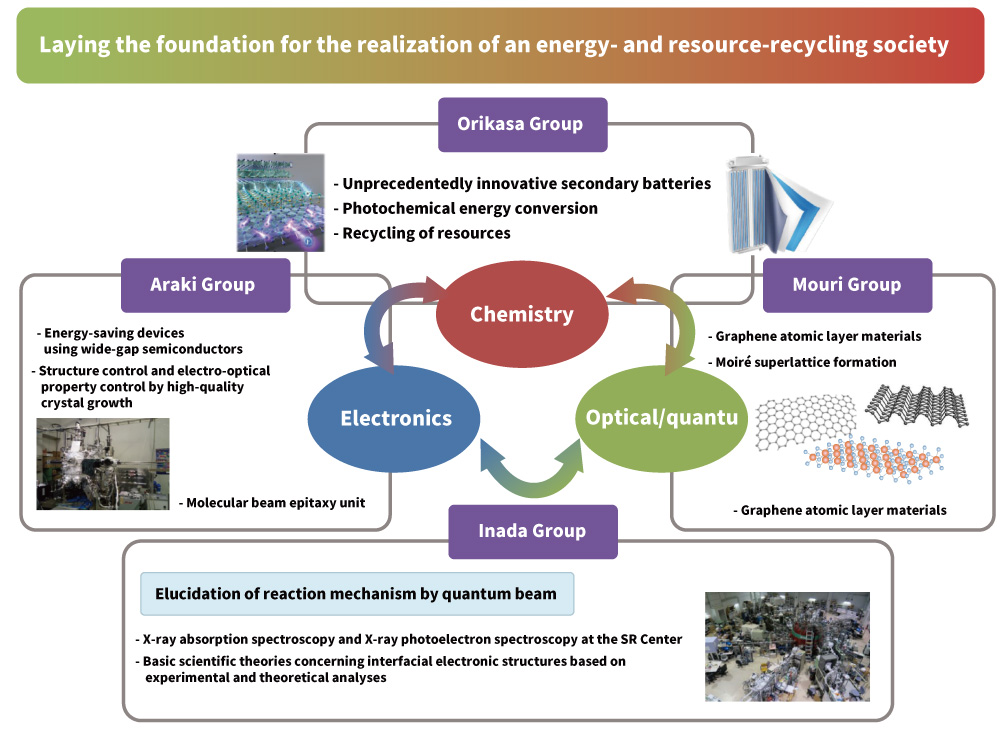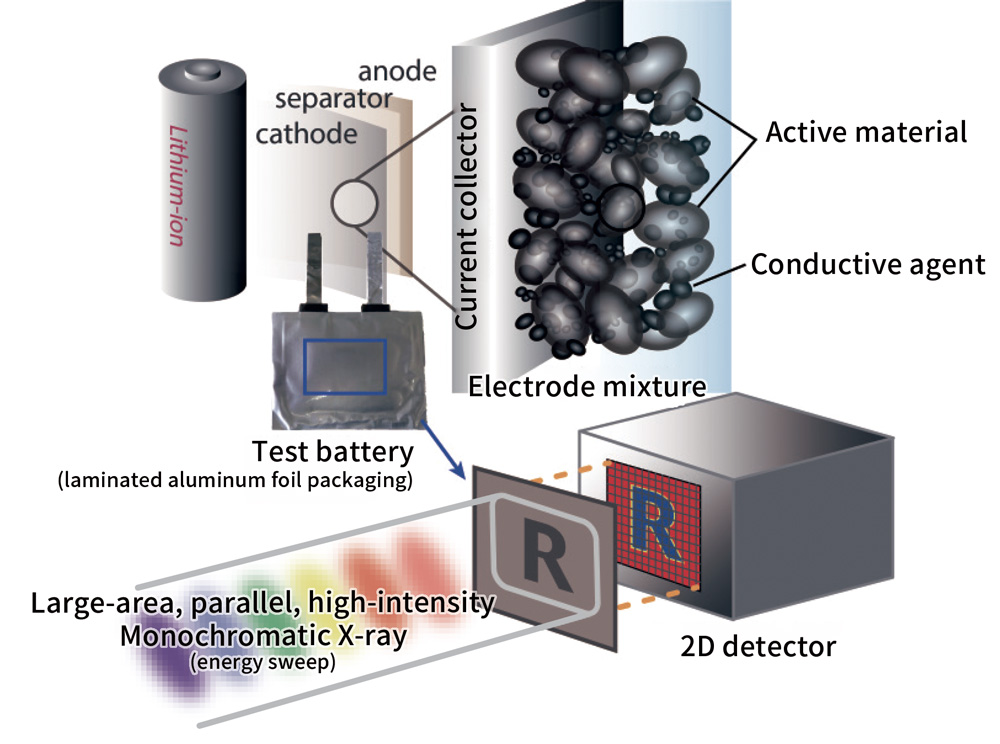Research AreaⅠ Restoration of the Earth's natural environmentHigh-Efficiency Energy Technologies for Carbon Neutrality
The fusion of chemistry, physics, and social sciences for innovation in the energy field
Leaders
-
Project leaderYuki OrikasaProfessor, Department of Applied Chemistry, College of Life SciencesProfile
-
Group leaderTsutomu ArakiProfessor, Department of Electrical and Electronic Engineering, College of Science and EngineeringProfile
-
Group leaderShinichiro MouriAssociate Professor, Department of Electrical and Electronic Engineering, College of Science and EngineeringProfile
-
Group leaderYasuhiro InadaProfessor, Department of Applied Chemistry, College of Life SciencesProfile
R-GIRO dedicated researcher
Developing next-generation technologies for better energy use and training of human resources capable of world-leading panoramic thinking
In the 21st century, we are faced with the urgent need to reduce greenhouse gas (GHG) emissions, as expressed in the 2015 Paris Agreement goal of limiting global warming to well below 2 (preferably 1.5) degrees Celsius, compared to pre-industrial levels. Although the movement toward carbon neutrality has been accelerating around the world, it is in fact extremely difficult to achieve in the current situation. For breakthrough, we researchers in natural and social sciences are working together in this project to form an original interdisciplinary research area that has never existed before, covering a whole range of subjects, from atomic and nano-level materials to macrosocial systems. Concretely, we attempt to develop innovative technologies for energy use that would contribute to the achievement of the GHG reduction targets stipulated in the Green Growth Strategy Through Achieving Carbon Neutrality in 2050 adopted by the Japanese government: 46% reduction by 2030 and net zero emissions by 2050. Our other goal in the project is the training of advanced researchers and specialists capable of serving as world leaders in the future energy field.
A multidisciplinary team working to develop devices that nobody has ever imagined as research targets
In the project, we try to construct basic theories concerning the control of interfaces, the starting point of reactions in energy devices. As for practical results, we develop low-cost, practically applicable devices enabling circulatory resource use, by incorporating results from research on societal policy and international situations, which are essential for new technologies to be adopted in society. One major advantage of this project is the use of quantum beam analysis at the Synchrotron Radiation (SR) Center of Ritsumeikan University, one of only 10 synchrotron radiation facilities in Japan. Another major characteristic is that, far from being limited to technological development, the project involves social science researchers who are expected to identify effective means to promote new technologies in society based on survey results concerning semiconductor/battery-related material circulation systems and comparative studies of related institutions between Japan and other countries.
The project is conducted by several groups working on their own respective themes. The Orikasa Group’s research target is the development of completely new secondary batteries that surpass existing lithium-ion batteries so as to establish a new principle for next-generation utilization. In recent years, with growing expectation for the practical application of all-solid-state secondary batteries using solid electrolytes, competition has been intensifying among researchers on a global scale. However, the next-generation secondary batteries that have been developed thus far have problems that are difficult to overcome, and a fundamentally new approach is eagerly awaited. Therefore, in our project, instead of targeting devices and reaction systems along the axes of existing research, we deliberately deviate from known pathways and set as our research targets secondary batteries that use polyvalent cations and iodide ions as carriers, which are completely opposite of lithium ions with low resource recovery, while using optical charging, which is the direct storage of optical energy, an inexhaustible energy source, as chemical energy. We will design devices and examine their principles from the perspectives of electrochemistry and inorganic chemistry to clarify their properties. We will also analyze factors for the spread of secondary batteries in society from a sociological perspective. By identifying factors necessary for the realization of recycling-based devices from the perspective of covering the whole process, from collection to recycling, we intend to create a secondary battery that is truly environment-friendly, demonstrating at the same time a new research method based on the fusion of the humanities, social sciences, and natural sciences.
Focusing on wide-gap semiconductors, a key technology for realizing carbon neutrality, the Araki Group is in charge of developing basic technologies for highly energy-efficient, energy-saving devices using wide-gap semiconductors. The group’s targets are nitride semiconductors, typically comprising gallium nitride, and oxide semiconductors, typically comprising gallium oxide. Wide-gap semiconductors are called as such because they have a larger bandgap than silicon. Due to their excellent physical properties, they have been used in optical devices, such as blue and white LEDs, and in electronic devices, such as high power devices, which has been impossible to do with silicon. Further improvements have rapidly and continuously been made on wide-gap semiconductors, but the basic technology enabling this progress, qualitative improvement of wide-gap semiconductor crystals, is still in the process of development and has not yet come to maturation. Therefore, with regard to nitride semiconductors, we will work on technological development concerning nitride semiconductor crystal growth and electro-optical property control by the molecular beam epitaxy method, which enables atomic-layer crystal growth in high vacuum. With regard to oxide semiconductors, we will use the mist chemical vapor deposition method, which is considered the leading Ga2O3 thin film crystal growth technology in the world, to develop the technology to generate materials for oxide semiconductor thin films and device property assessment technology.
The Mouri Group aims to develop novel “Energy-harvesting” technologies by controlling atomic scale interface. They are challenging to characterize the electric, heat or optical energy flow at the van der Waals stacking of atomically thin-layered materials and establish their control method based on quantum effect induced by geometric modulation of these materials such as formation of moiré superlattice.
In parallel with the above-mentioned group-based research, inter-group collaborative research is also being pursued. The Orikasa Group intends to discover materials in unexplored areas through device design into which research findings in electronic engineering and quantum science are incorporated. Moreover, basic technologies will be developed for new functional devices using wide-gap semiconductors, with the Araki Group looking into a new energy storage device that combines semiconductors with the Orisaka Group’s battery materials and a new heterostructure device combining wide-gap semiconductors with the Mouri Group’s atomic-layer materials. Meanwhile, the Mouri Group intends to develop high-efficiency electrodes for energy storage devices, which the Orikasa Group is working on, while promoting the regenerative use of exhaust heat from energy-saving devices studied by the Araki Group. Furthermore, with interfacial reactions using quantum effects, the groups will attempt to realize highly efficient energy transportation that cannot be attained with semiconductor or battery materials alone.
Finally, the Inada Group is in charge of state analysis of element groups constituting next-generation functional materials, such as next-generation secondary battery materials, photo-chemical energy conversion materials, semiconductor crystal quantum nanostructure materials, and atomic layer materials, using synchrotron radiation facilities, the SR Center of Ritsumeikan University, which allows material analysis with high-intensity quantum beams. The group will analyze the mechanisms of new technologies to be created by the Orikasa, Araki, and Mouri Groups by X-ray absorption spectroscopy, photoelectron spectroscopy, and soft X-ray microscopy so as to clarify their novelty from a scientific standpoint beyond the perspective of practical application. The group will thus attempt to induce a breakthrough in the functional aspect with the emergence of new functions in energy-related materials to be developed by catalytic chemical processes. Besides integrating research results by the Orikasa, Araki, and Mouri Groups to promote the application of their technologies to device design in other domains, the group also trains, through material analysis, graduate students and young researchers so that they can develop panoramic research capabilities encompassing academic achievement, contribution to the industrial community, advanced analysis, and more, thereby helping to realize carbon neutrality.
-

Research results envisaged in this project
Capturing research “seeds” for next-generation devices by departing from conventional research directions
As stated above, in this project, we deliberately deviate from conventional research directions so as to discover new research subjects that can solve problems in existing energy conversion devices. Through this approach, we hope to create new principles of reaction and a new basic direction for practical device design, with which we can enhance the performance of existing energy devices and create new, world-leading energy devices. For demonstration, we would like to install our future power storage infrastructure and other technologies at the Biwako-Kusatsu Campus (BKC) to transform it into a carbon-free campus. We hope that the results from this project will dramatically accelerate device research and eventually lead to greater results, perhaps even a Nobel Prize 50 years from now.
-

How to directly observe secondary battery internal phenomenon during reaction
077-561-3488 (9:00-17:30 on weekdays)
072-665-2570 (9:00-17:30 on weekdays)
075-465-8224 (9:00-17:30 on weekdays)
